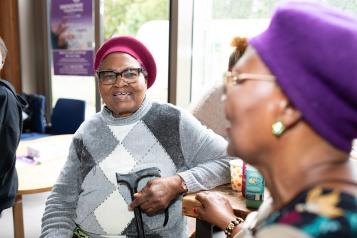Making care homes a better place to live

At the time of the 2011 census, 291,000 people aged 65 or over were living in care homes in England and Wales. The majority of whom were aged 85 years or over.
Like any health or care service, it is important that care homes provide support that meets the needs of residents but how will we know if this is happening, especially when many services report being under financial pressure?
We look at one example of how local Healthwatch is helping.
Finding out if services work for people
“Like many areas, in Lancashire we have a growing number of older people and some real funding challenges when it comes to the services that support them.
“We knew that some services were under real pressure and we wanted to see how this was affecting local people” said Sheralee Turner- Birchall, Chief Officer at Healthwatch Lancashire, explaining why they have visited 32 care homes to hear what people had to say about the care they were receiving.
What happens during a care home visit?
With the help of 17 trained volunteers, the local Healthwatch undertook a series of visits where they asked residents for their views about the care, accommodation, the food and the activities provided.
There are always things happening and we are given freedom to do what we like. There is plenty of time to catch up with each other and make friends.
The local Healthwatch also asked staff about their experiences of working at the homes and gathered the views of friends and relatives of residents.
How were people's views used?
Each home was then provided with a report detailing what people said worked well, as well as any concerns raised.
“Many residents were broadly happy with the care they are getting, although there is always room for improvement and most homes want to know what their residents think.
“However, the key thing is that our findings are also shared with those who commission local services, as well as the Care Quality Commission (CQC) whose job it is to inspect services and make sure they are safe and provide quality care” explains Sheralee.
Healthwatch Lancashire, like many local Healthwatch, works closely with the CQC inspection teams, sharing their findings, which CQC often uses to help decide which services to be inspected in the future.
Sheralee explained how this works in practice, “After visiting a care home that had been rated ‘Good’ by the CQC six months earlier, we contacted local commissioners, the council and the CQC to share concerns that residents had raised with us.
“Together we worked with the home to help them change things. The care home put together an action plan to make a series of improvements and we plan to visit them again to see if the experience of residents has got better. We have recently revisited the home and the changes which have been made in line with our findings were significant and demonstrate the impact local Healthwatch can have on the lives of those using local services."
Have there been any other changes?
“After sharing what people said with providers, commissioners and inspectors we have seen some real improvements in care homes across the county”, said Sheralee.
“Care homes have now become particularly good at sharing best practice with each other and staff are better informed about what is working well for residents and what they think could be better.
“We are also using our findings to write a new guide for care homes, including a checklist that people and their loved ones can use to help choose the right home.
“This is a great example of how - if people are willing to share their views - staff, inspectors and Healthwatch can work together to improve care."


